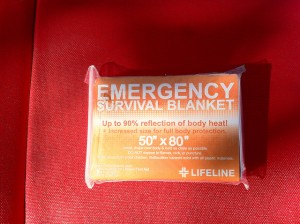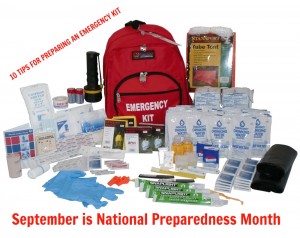What You Need To Be Prepared For The Worst
“Hope for the best but prepare for the worst,” the old saying goes. A good adage, but for the intents and purposes of having your home ready for an emergency, “prepare for the worst” is the part to focus on. September is National Preparedness Month, so read on and learn more about how you can ensure that you and your loved ones will have everything you need if (knock on wood) disaster strikes.
Unfortunate recent events have proven that extraordinary circumstances can quickly arise. Natural disasters like hurricanes or floods can impact any part of the country, and even more docile situations like massive, long-term blackouts can make for a sticky situation. You have to be ready, for yourself and your family. At the very least, when the zombie invasion hits you’ll be happy you read up on this.
The first tip is to have everything in one place. In the event of a sudden situation – say, you have to evacuate at a moment’s notice, or your power shuts off for days – you might find it quite difficult to locate all the essentials in a pinch. Avoid getting caught off guard by socking away a basic kit in a suitcase or a clear plastic container. Having at least 72 hours’ worth of supplies on hand is a good rule of thumb. Especially if the situation dictates time as a factor you will thank your past self for being prepared!
What do you need most in the event of an emergency? Here are 10 bases to cover in your emergency preparedness kit:
1) Water: But you already knew that, seeing as it’s the lifeblood of mankind and all. The Federal Emergency Management Agency suggests you store one gallon of water per day for each person in your household. This will serve both drinking and sanitation purposes, in case your water supply is cut off. Stock up with a few jugs of Poland Spring so you don’t go thirsty (or dirty) in an emergency!
2) Food: Where there is water there is generally food also, but in this case you need the right kinds. If there is a massive snowstorm that knocks out power and precludes you from leaving the house, or an evacuation forces you into a temporarily unstable living situation, you’re going to need a store of the right non-perishable foods. A few tips to keep in mind: first, avoid foods that will make you thirsty, thus conserving your water. Also, make sure you choose foods you or your family will eat, and account for any special dietary needs. FEMA lists the following non-perishable foods as useful in an emergency situation: canned fruits, vegetables and meats that are ready to eat (be sure to include a can-opener with these); nuts, granola and fruit bars; dry cereal; peanut butter: canned juices and non-perishable pasteurized milk; vitamins; food for an infant, if you’ve got one of those around; and finally, add a few bags of Doritos or a candy bar or two so you can make yourself feel a little better about the situation. All of these foods require no cooking or special preparation, therefore they are all highly useful in case of an emergency!
3) Paper Goods: Plates, cups, utensils…whether you’re stuck at home or on-the-go, your water and non-perishable foods need to be served somehow, so your emergency preparedness kit should include plenty of paper goods. It’s probably a safe bet that the dishwasher will be out of commission while power is out, so glassware is out of the question. Also, have trash bags on hand to keep a mess from piling up.
4) First Aid Kit: Medical ailments unfortunately will not cease with respect to an emergency, so if you or a family member suffers from a specific condition it is essential to have whatever specialized medicine is needed in extra amounts in your emergency kit. In any case, basic medicines like Aspirin or Benadryl are useful to keep on hand. Bandages and gauze should also be included in your first-aid kit in case minor injuries crop up during an emergency. When it comes to health you can never be too prepared, so read more here on what constitutes a full first-aid kit.
5) Clothes/Blankets: There are few things on Earth that can’t be made worse by freezing cold. Especially if an emergency coincides with the dead of winter it is a must to account for extra clothes and blankets to combat harsh temperatures. At least one full change of clothing is recommended per person, including a long shirt and long pants, and additional clothes are suggested if you live in a cold-weather climate. Sleeping bags are another way to fight the cold. 
6) Documents/Cash: If your forced from home for an extended period of time there are certain documents you will need to have on you, such as copies of insurance policies or bank account records. Be sure to seal these copies in water-proof casing. Also, keep a moderate amount of cash in your emergency kit so you have access to the things you need! Traveler’s checks are another smart item to include.
7) Light: Let there be light to guide you through an emergency. Natural disasters and loss of power seem to go hand-in-hand, so make sure you’re not left in the dark by including flashlights and lanterns as well as batteries to power them in case of an emergency. A few things to consider here: double-check that you have the correct type of battery to correspond with the light sources that need them. AA’s and AAA’s are the most common kinds of batteries so make sure you have plenty of those, but also consider that heavy-duty flashlights are commonly powered by D-cell batteries. Having ample light sources will make everything else easier in an emergency, so don’t forget the forefather of electricity, fire. When shrouded in darkness and lacking in electrical options, lighters and matches can still very much come in handy to ignite candles or stand alone as light sources. Keep matches in your emergency kit in a water-proof container and throw a couple of lighters in there as well. A small fire extinguisher is another useful item if you can fit it in.
8) Radios: Radios are essential in an emergency. Use a standard battery-powered AM/FM radio to stay up-to-date on a developing situation, and have a NOAA Weather Radio on hand also. Make sure to cover all your bases here to make sure you don’t miss anything!
9) Personal Hygiene products: Hopefully your home is already equipped with deodorant, shampoo, soap and the like, but if you’re thrust into an evacuation situation you’ll need these items to stay fresh in the midst of chaos. Many stores sell travel-sized kits with basic hygienic products included.
10) Leisure Items: Say you and your loved ones are trapped inside for days on end. Especially in the era of electronics this could produce at best some serious boredom and at worst, severe stir-craziness. Books and board games, are perfect candidates for revival in case an emergency renders your electronics temporarily useless!
Of course, there are many more tips than just these for assuring you and your family’s safety and comfort in an emergency. You can read more on emergency preparedness and National Preparedness Month on FEMA’s website. Hopefully you never have to call it into action, but preparing an emergency kit ensures you will be ready for whatever comes your way!



